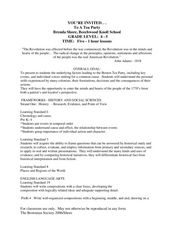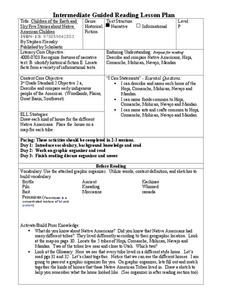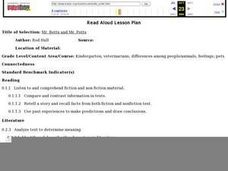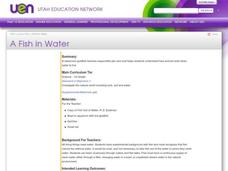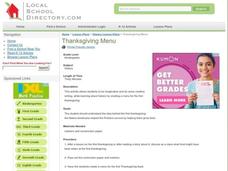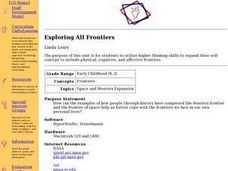Curated OER
The Life And Times Of The Apple
Students engage in a study about the biology of apples that includes growth and reproduction. They conduct research using a variety of resources. Students write a description of an apple brought to class by answering several questions....
Curated OER
You're Invited...To A Tea Party
Kids read the book Boston Tea Party by Steven Kroll and use maps to locate various landmarks. They identify the cause and effect of the events related to the Boston Tea Party, then write a descriptive composition.
Curated OER
Plants are Growing and Changing
Students explore living things. In this agriculture lesson plan, students read the book A Tree is a Plant and participate in an experiment to explore the patterns of change in living things. Students continue to observe the plant...
Curated OER
Charlotte's Web
Fourth graders focus on fluency by reading the book Charlotte's Web. In this reading strategies instructional activity, 4th graders partner read, do guided reading, and independent reading to increase fluency. Students use Venn...
Curated OER
Amelia Earhart: A Biography
Second graders investigate the accomplishments of Amelia Earhart. They read and discuss a biography of Amelia Earhart, complete a Venn diagram, and conduct an interview with a classmate and write and publish a biography of their classmate.
Curated OER
Human Migration
Students explore human migration, refugees and human rights. They read articles about immigration, create a migration journal, and participate in a mock human rights commission meeting. After collecting information about immigration,...
Curated OER
Counting Crows
Young scholars discuss the fable, The Crow and the Pitcher. In this literature instructional activity, students read the fable and create a crow sock puppet. Young scholars use their puppets to dramatize the fable.
Curated OER
Intermediate Guided Reading Lesson Plan
Third graders read Children of the Earth and Sky: Five Stories about Native American Children by Stephen Krensky. In this guided reading lesson, 3rd graders gain knowledge about various Native American tribes. Using a graphic organizer...
Curated OER
"A Pig is Big"
Students explore the concept of big, bigger, and biggest. They examine and classify items by size, listen to and discuss the book "A Pig is Big," complete a fill in the blank activity, and create a tri-fold that illustrates two items...
Curated OER
"Mr. Betts and Mr. Potts"
First graders listen to the book "Mr. Betts and Mr. Potts" and examine the career of being a veterinarian. They categorize animals based on whether they could be house pets or not, develop a class pet graph, and list the various...
Curated OER
A Fish in Water
First graders, with a goldfish as a class pet, practice the proper way to care for a pet and have responsibilities when it comes to taking care of the fish. As a class, the teacher reads the book "Fish Out of Water".
Curated OER
Inquiry into Heat Loss and Insulation
Learners design an experiment to test the problem of the porridge in Baby Bear's bowl as being just right while the other porridge was either too hot or too cold. They explain the steps of their experiment and record their observations...
Curated OER
Strategic Skill: Evaluating Information Quality Using Electronic Sources
Fourth graders review and complete evaluating information quality. In groups, they research the diversity of the numerous Native American tribes in Montana. They complete a worksheet on evaluating sources on the Internet and share...
Curated OER
Thanksgiving Menu
Pupils explore the First Thanksgiving. In this U.S. history lesson, students read about the Pilgrims and Native Americans and discuss how they obtained and prepared food. Pupils develop a possible first Thanksgiving menu and draw a...
Curated OER
Dogsong
Students read the Gary Paulsen novel, Dog song, about wilderness survival, and research information about the Iditarod dogsled race. Students follow the sled race online each day and complete an Alaska scavenger hunt.
Curated OER
Exploring All Frontiers
Young scholars utilize higher thinking skills to expand their self concept to include physical, cognitive, and affective frontiers. The teacher create activities which allow students to use raw data and primary sources, as well as...
Curated OER
The Crucible
Twelfth graders use an Internet scavenger hunt, vocabulary, sample essay questions, and short answer questions suitable for study and review of the play, The Crucible.
Curated OER
Where Is Xinjinag?
Students geographically recognize the territory of Xinjiang Province by identifying the physical landscape and important cities. They see how human rights issues have affected the global, political, and economic arena in Xinjiang.
Curated OER
Bias vs. Perspective: An Inevitable Aspect of Journalism?
High schoolers explore the types of media that U.S. teens prefer the ways in which viewers identify and account for journalistic bias. They explore the ways in which media shapes one's opinion or affects their judgment.
Curated OER
Build Your Own Adventure
Sixth graders write a narrative. They choose options for plot and climax within the context of an outdoor survival story.
Curated OER
Exploring Literature and Weather through Chirps
Students explore and experience information about temperature changes by using crickets' chirps to calculate the temperature. The data is applied to formula and the temperatures are calculated.
Curated OER
The Western Hemisphere on Review
Sixth graders research a country in the Western Hemisphere. They write a research paper and present a five-minute presentation on the country. They use PowerPoint to give their presentations to the class.
Curated OER
Exploring Literature And Weather Through Chirps
Young scholars explore using crickets' chirps to calculate temperature. They read "Cricket in Times Square" and "The Quiet Cricket," read and discuss a Cricket eBook, develop a formula and calculate temperature using cricket chirps, and...
Curated OER
Adjectives
Students list adjectives to describe Anakin, his cloak and the mood of the poster to write an adjective-rich description. They then sort the adjectives into categories of what they describe: people, places, or things.

